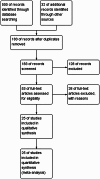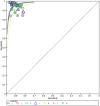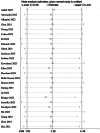Accuracy of multimodal vaginal ultrasound in the detection and assessment of scar healing after caesarean section: a correlational meta-analysis
- PMID: 40587769
- PMCID: PMC12210417
- DOI: 10.1080/07853890.2025.2523558
Accuracy of multimodal vaginal ultrasound in the detection and assessment of scar healing after caesarean section: a correlational meta-analysis
Abstract
Objective: To evaluate the accuracy of multimodal vaginal ultrasound in assessing post-caesarean scar healing.
Methods: A systematic review and meta-analysis were conducted on Chinese and English studies using multimodal vaginal ultrasound to diagnose poor scar healing post-CS. Two researchers screened literature based on inclusion/exclusion criteria. Quality assessment and meta-analysis (RevMan 5.4, Stata14.0, Meta-DiSc1.4) were performed for various diagnostic indicators.
Results: Twenty-five high-quality studies identified key ultrasound markers: hypoechoic/anechoic scars (sensitivity 92%, specificity 91%), thinning/discontinuity of the myotomy layer (sensitivity 95%, specificity 90%), blurred incision contour (sensitivity 99%, specificity 91%), absent blood flow (sensitivity 92%, specificity 91%), irregular lesion morphology (sensitivity 95%, specificity 90%), uneven myometrial echogenicity (sensitivity 94%, specificity 91%), lower uterine segment thickness ≤3.73 mm (sensitivity 90%, specificity 88%), and myometrial lining ≤1.5 mm (sensitivity 90%, specificity 92%).
Conclusion: Multimodal vaginal ultrasound is highly accurate in detecting poor CS scar healing, aiding early intervention to prevent complications.
Keywords: META; Multimodal vaginal ultrasound; caesarean section; diagnosis; scar healing.
Conflict of interest statement
No potential conflict of interest was reported by the author(s).
Figures














Similar articles
-
Risk of Cesarean scar defect following single- vs double-layer uterine closure: systematic review and meta-analysis of randomized controlled trials.Ultrasound Obstet Gynecol. 2017 Nov;50(5):578-583. doi: 10.1002/uog.17401. Epub 2017 Oct 9. Ultrasound Obstet Gynecol. 2017. PMID: 28070914
-
Laparoscopic repair of the caesarean section scar niche: A prospective cohort study.PLoS One. 2025 Jul 2;20(7):e0318592. doi: 10.1371/journal.pone.0318592. eCollection 2025. PLoS One. 2025. PMID: 40601781 Free PMC article.
-
Sonographic lower uterine segment thickness and risk of uterine scar defect: a systematic review.J Obstet Gynaecol Can. 2010 Apr;32(4):321-327. doi: 10.1016/S1701-2163(16)34475-9. J Obstet Gynaecol Can. 2010. PMID: 20500938
-
A prospective study on risk factors associated with the development of isthmocele after caesarean section.J Ultrasound. 2024 Sep;27(3):679-688. doi: 10.1007/s40477-024-00919-3. Epub 2024 Jun 23. J Ultrasound. 2024. PMID: 38909346
-
Diagnostic yield of transvaginal ultrasonography versus saline: infused sonohysterography in the evaluation of post-cesarean section uterine niche.J Ultrasound. 2025 Mar;28(1):107-117. doi: 10.1007/s40477-024-00969-7. Epub 2024 Nov 18. J Ultrasound. 2025. PMID: 39556186
References
-
- Budny-Wińska J, Zimmer-Stelmach A, Pomorski M.. Impact of selected risk factors on uterine healing after cesarean section in women with single-layer uterine closure: a prospective study using two- and three-dimensional transvaginal ultrasonography. Adv Clin Exp Med. 2022;31(1):41–48. doi: 10.17219/acem/142519. - DOI - PubMed
Publication types
MeSH terms
LinkOut - more resources
Full Text Sources
Medical
